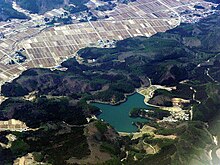| Fujinuma Dam | |
|---|---|
 Fujinuma Reservoir in 2009 with dam at center bottom, auxiliary dam on left edge of reservoir | |
| Country | Japan |
| Location | Sukagawa City |
| Coordinates | 37°18′07″N 140°11′41″E / 37.30194°N 140.19472°E |
| Status | Failed |
| Opening date | 1949 |
| Owner(s) | Ebana River Coastal Reclamation District |
| Dam and spillways | |
| Type of dam | Embankment |
| Impounds | Ebana River |
| Height | 18.5 m (61 ft) |
| Length | 133 m (436 ft) |
| Width (crest) | 6 m (20 ft) |
| Dam volume | 99,000 m3 (3,496,152 cu ft) |
| Reservoir | |
| Creates | Fujinuma Reservoir |
| Total capacity | 1,504,000 m3 (1,219 acre⋅ft) |
| Catchment area | 8.8 km2 (3 sq mi) |
| Surface area | 20 ha (49 acres) |
The Fujinuma Dam (藤沼ダム, Fujinuma Damu),[1] was an earth-fill embankment dam in Sukagawa City, Fukushima Prefecture, Japan. It was established on the Ebana River, a tributary of the Abukuma River, 16 km (10 mi) west of the city office of Sukagawa City. Construction on the dam commenced in 1937 and it was completed in 1949 after construction was halted due to World War II.[2] The dam's primary purpose was irrigation. It failed on 11 March 2011 after the 2011 Tōhoku earthquake.
- ^ Cite error: The named reference
fujinuwas invoked but never defined (see the help page). - ^ Harder, Leslie F.; Keith I. Kelson; Tadahiro Kishida; Robert Kayen (6 June 2011). "Preliminary Observations of the Fujinuma Dam Failure Following the March 11, 2011 Tohoku Offshore Earthquake, Japan" (PDF). Geotechnical Extreme Events Reconnaissance (GEER). GEER Association. Archived from the original (PDF) on 24 November 2011. Retrieved 15 July 2011.